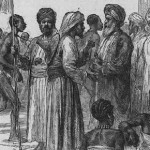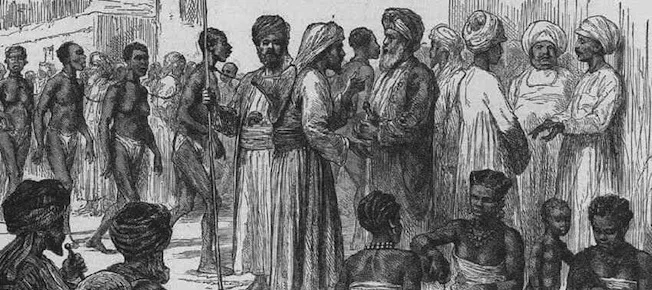 We've seen that the New Testament writers, most notably Paul, did not directly attack the institution of slavery. Paul advised slaves to obey their masters, to work conscientiously even when unsupervised (Eph. 6:5-8; Col. 3:22-23), to be trustworthy and not steal the master's property (Tit. 2:9), and to think of and emulate Christ when suffering unjustly (1 Pet. 2:18-23). Masters were admonished to treat their slaves justly and not to threaten them, but to recognize that in God's eyes the slave was as valuable as his master (Eph. 6:9; Col. 4:1; Col. 3:11; Gal. 3:28).
We've also seen how this advice was applied in the case of Onesimus, a slave in what is now Turkey, who stole money from his master, ran away to Rome, was converted to Christianity, and became a helper to Paul. Paul sent Onesimus back to his master, Philemon (who was also a Christian whom Paul had converted), bearing a letter telling Philemon to treat Onesimus just as he would treat a son of Paul. Philemon was to think of Onesimus not as having run away but as having gone on a Christian mission in Philemon’s stead, to treat him not as a slave but as a brother, and not even to mention the money he had stolen when he ran away. In effect, Paul had replaced Roman law and custom relating to slavery with a new standard of Christian behavior.
We've seen that the New Testament writers, most notably Paul, did not directly attack the institution of slavery. Paul advised slaves to obey their masters, to work conscientiously even when unsupervised (Eph. 6:5-8; Col. 3:22-23), to be trustworthy and not steal the master's property (Tit. 2:9), and to think of and emulate Christ when suffering unjustly (1 Pet. 2:18-23). Masters were admonished to treat their slaves justly and not to threaten them, but to recognize that in God's eyes the slave was as valuable as his master (Eph. 6:9; Col. 4:1; Col. 3:11; Gal. 3:28).
We've also seen how this advice was applied in the case of Onesimus, a slave in what is now Turkey, who stole money from his master, ran away to Rome, was converted to Christianity, and became a helper to Paul. Paul sent Onesimus back to his master, Philemon (who was also a Christian whom Paul had converted), bearing a letter telling Philemon to treat Onesimus just as he would treat a son of Paul. Philemon was to think of Onesimus not as having run away but as having gone on a Christian mission in Philemon’s stead, to treat him not as a slave but as a brother, and not even to mention the money he had stolen when he ran away. In effect, Paul had replaced Roman law and custom relating to slavery with a new standard of Christian behavior.
We have little extra-biblical, historical evidence for how Christians related to slavery, but what there is is interesting and instructive.
Paul tells free Christians that although they are Christ's slaves, they were bought with a price and are not to become slaves of other men. (1 Cor. 7:21-23) But Paul's advice was early ignored, albeit for good causes; Clement of Rome writes (c. 96 AD) that, “We know many among ourselves who have given themselves up to slavery, in order that they could ransom others. Many others have surrendered themselves to slavery, so that with the price that they received for themselves, they might provide food for others.” Some Christians were selling themselves into slavery in order to free others or provide for the needs of others.
We also have evidence that the church sometimes used its funds to purchase freedom for slaves. This is hinted at in an early Second Century letter from Ignatius, Bishop of Antioch, to Polycarp, Bishop of Smyrna. It is stated more clearly, some centuries later, in the Apostolic Constitutions (c. 390 AD) which provide that, “As for such sums of money as are collected from them in the aforesaid manner, designate them to be used for the redemption of the saints and the deliverance of slaves and captives.”
It had become common by the early 4th century for Christian masters to free their slaves. These religiously motivated manumissions were performed in church in the presence of a bishop. An early ruling of Constantine, made in response to petitions from bishops, refers to slave owners freeing their slaves because of their religious convictions (“religiose mente”). That this was an accepted practice in Constantine's time suggests that it probably began long before then. There was no requirement that Christian masters free their slaves---and certainly not all did---but it is significant that a custom developed pursuant to which (1) Christian masters (2) freed their slaves (3) in a church ceremony (4) before a bishop (5) ultimately with the bishop-requested authority of the emperor.
We also have reports that when extremely wealthy Romans were converted to Christianity, they freed their slaves en masse. When the prefect Hermas was converted by Bishop Alexander during the reign of Trajan (r. 98-117), he was baptized at an Easter festival along with wife, children, and twelve hundred and fifty slaves, to all of whom (the slaves, that is) he gave their freedom plus monetary compensation. In the time of Diocletian (r. 284-305) the prefect Chromatius was baptized with his fourteen hundred slaves whom he also emancipated at the same time, proclaiming that their sonship to God had put an end to their servitude to man. Church historian Phillip Schaff states that, “these legendary traditions may indeed be doubted as to the exact facts in the case, and probably are greatly exaggerated; but they are nevertheless conclusive as the exponents of the spirit which animated the church at that time concerning the duty of Christian masters."
Indeed, it is difficult to imagine why, if the early Christian Church endorsed slavery, it should have (1) used church funds to free slaves, (2) developed a bishop-led church ceremony in which slaves were freed, and (3) encouraged wealthy converts to manumit their slaves en masse. The logical conclusion is that slavery was a pagan institution that the Christian Church did not view as God's ideal form of social organization. But re-organizing society has never been the primary function of Christianity. Christianity changes hearts, and enough changed hearts will eventually lead to a changed society.
After the collapse of the Western Roman Empire, its legal forms and customs, including slavery, gradually fell into disuse and were replaced by what has become known as feudalism, a decentralized system of reciprocal legal and military obligations. By the late Middle Ages slavery had disappeared in Western Europe (although it persisted until much later in parts of Eastern Europe). The slave's feudal counterpart was the peasant who was bound to work specific land and could not move or change his occupation. The peasant's plight bore some similarities to slavery (especially in Russia, where serfs could be bought and sold) but was really a very different kind of institution.
Slavery was unambiguously legitimate in Islam; Muhammad owned slaves, and Muslims consider him the perfect example to emulate. Non-Muslims captured in raiding, piracy, and Jihad warfare were booty; and volumes of Islamic jurisprudence are devoted to regulating the distribution of booty. Although Muslims enslaved millions of black Africans—one common Arabic term for slave, abd or abeed, is also a slang term for a black person---they were equal opportunity slavers and frequently enslaved Europeans, especially from southeastern Europe. Slavery in Muslim lands was typically ended only when they were colonized by the Western powers.
Related articles 1. Slavery and the Bible (Part I) 2. Slavery and the Bible (Part II)

